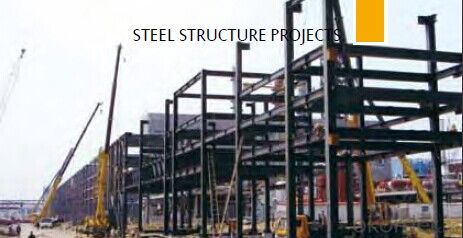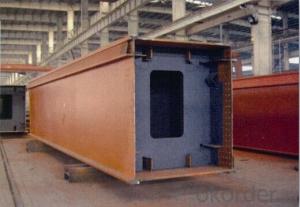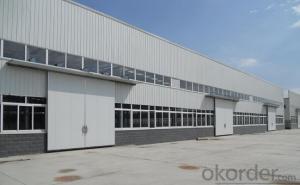High-end Steel-work
- Loading Port:
- China Main Port
- Payment Terms:
- TT OR LC
- Min Order Qty:
- -
- Supply Capability:
- -
OKorder Service Pledge
OKorder Financial Service
You Might Also Like
Steel Structure
Description:
1.Length of the welding withnot indication, full welding should be applied
2.Seam without indication is fillet weld, height is 0.75t
3.The cutting angle without indication, radius R=30
4.Cutting angle not specified should be
5.The diameter of the hole for the bolt if not specified, D=22

Project Reference:
For the Steel structure project of Upper part of external
piperack for air separation and gasifying facilities of
460,000 tons MTO (Methanol to Olefins) project in
Duolun, we provide about 4,500 tons steel structure. It
is a heavy chemical indusry of national energy project.

- Q:How are steel structures used in military and defense installations?
- Steel structures are used in military and defense installations for various purposes including the construction of barracks, command centers, hangars, warehouses, and other facilities. Steel provides strength, durability, and resistance to extreme weather conditions, making it suitable for protecting personnel, equipment, and supplies. Additionally, steel structures can be easily modified or expanded to accommodate changing needs and can withstand potential threats like explosions or ballistic impacts, enhancing the security and operational efficiency of military and defense installations.
- Q:How are steel stadiums and arenas constructed?
- Steel stadiums and arenas are constructed using a combination of pre-fabricated steel components and on-site assembly. The process typically involves first designing the structure and creating detailed blueprints. Then, the steel framework is fabricated off-site and transported to the construction site. Once on-site, the steel components are assembled and welded together to form the skeleton of the stadium or arena. Additional elements such as roofing, seating, and other amenities are then added to complete the construction.
- Q:What are the considerations for designing steel structures for blast resistance?
- When designing steel structures for blast resistance, several key considerations need to be taken into account. Firstly, the structural design should include provisions for the dynamic loads generated by the blast, such as the blast pressure, impulse, and duration. This involves determining the blast design criteria and considering the potential threat scenarios. Secondly, the choice of materials and their properties play a crucial role. Steel, due to its high strength and ductility, is commonly used for blast-resistant structures. However, the selection of the specific steel grade and its resistance to brittle fracture and spalling should be carefully assessed. Thirdly, the structural configuration needs to be optimized to enhance blast resistance. This involves incorporating blast-resistant features such as robust connections, reinforced walls, and blast-resistant windows. The structural system should also be designed to minimize the potential for progressive collapse. Additionally, blast-resistant design requires considering the location and proximity of the structure to potential explosion sources. The standoff distance, surrounding terrain, and potential mitigating factors should be evaluated to determine the appropriate level of blast resistance required. Finally, it is crucial to adhere to relevant design codes, guidelines, and standards specific to blast-resistant design. These standards provide valuable information on blast loading, material specifications, and structural design requirements to ensure the safety and performance of the steel structure in the event of a blast.
- Q:What are the different types of steel members used in building structures?
- Building structures commonly utilize various types of steel members, each serving a specific purpose. These include: 1. Beams: Horizontal structural members that bear loads and uphold the weight of the structure above. They are suitable for spanning large distances and uniformly distributing the load. 2. Columns: Vertical structural members that offer support and stability to the structure. Their purpose is to transfer the load from the beams to the foundation. 3. Trusses: Frameworks of beams, often triangular in shape, employed to support a building's roof or floor. They possess a lightweight yet robust nature, making them ideal for spanning extensive areas. 4. Plates: Flat, thin sheets of steel used to reinforce and bolster various parts of the structure. Depending on the specific application, they can function as base plates, gusset plates, or shear plates. 5. Lintels: Horizontal structural members that provide support above an opening, such as a door or window. Typically constructed from steel beams or angles, they ensure the even distribution of load to the surrounding walls. 6. Bracing: Utilized to enhance stability and prevent the collapse of structures due to lateral loads like wind or earthquakes. Bracing members may take the form of diagonal steel members or X-shaped braces, depending on design requirements. 7. Purlins: Horizontal structural members that support the roof covering and transfer the load to the primary beams. Frequently employed in metal building systems, they enhance the strength and stability of the roof structure. In conclusion, these diverse steel members play a vital role in constructing building structures, providing strength, stability, and support to ensure the overall structure's safety and durability.
- Q:Can steel structures be designed with large spans?
- Yes, steel structures can be designed with large spans. The high strength-to-weight ratio of steel allows for the construction of long-span structures that can span great distances without the need for additional supports. The versatility and flexibility of steel as a construction material make it suitable for designing structures with large spans, such as bridges, stadiums, aircraft hangars, and industrial buildings.
- Q:How are steel structures used in the construction of theme parks and amusement centers?
- Steel structures are commonly used in the construction of theme parks and amusement centers due to their strength, durability, and versatility. They provide the necessary support for large-scale rides, roller coasters, and other attractions, ensuring the safety and stability of these structures. Steel is also ideal for creating intricate and unique architectural designs, allowing for the creation of visually impressive structures that enhance the overall experience for visitors. Moreover, steel's ability to withstand extreme weather conditions makes it a reliable choice for outdoor amusement parks.
- Q:What are the key considerations for maintaining and inspecting steel structures?
- Some key considerations for maintaining and inspecting steel structures include regular inspections to identify any signs of corrosion, wear and tear, or structural damage. It is important to have a comprehensive maintenance plan in place that includes cleaning, repainting, and applying protective coatings to prevent corrosion. Regular inspections should also include checking for any loose connections, cracks, or deformations in the structure. Additionally, it is crucial to comply with relevant safety regulations and standards, and to have qualified professionals conduct the inspections and necessary repairs.
- Q:What are the considerations for designing steel parking structures?
- When designing steel parking structures, several considerations need to be taken into account. First and foremost, structural integrity is crucial. The design should ensure that the structure can support the weight of multiple vehicles and withstand the various loads it may experience, such as snow, wind, and seismic forces. Another important consideration is the layout and efficiency of the parking structure. Proper circulation and traffic flow need to be planned to ensure smooth movement of vehicles, as well as the availability of adequate parking spaces. The design should also consider factors like lighting, signage, and security measures to enhance safety and user experience. Additionally, the materials and finishes used in the construction of the parking structure should be carefully chosen. Steel, being a durable and versatile material, is commonly used due to its strength and ability to span long distances. The finishes should be resistant to corrosion and provide proper drainage to prevent water damage. Furthermore, accessibility and compliance with local building codes and regulations are essential considerations. The design should incorporate features that make the parking structure accessible to individuals with disabilities, including ramps, elevators, and designated parking spaces. It should also adhere to fire safety regulations and include appropriate ventilation systems. Lastly, sustainability should be considered in the design of steel parking structures. Incorporating energy-efficient lighting, green roofing systems, and rainwater harvesting can contribute to reducing the environmental impact of the structure. Overall, the considerations for designing steel parking structures encompass structural integrity, layout efficiency, material selection, accessibility, compliance with regulations, and sustainability.
- Q:Are there many knowledge of structural mechanics in steel structure? What about material mechanics?
- The whole course of civil engineering, is to learn in a few basic premise in mechanics, if the mechanics is not good, like steel structure, concrete structure of this class, you can only learn fur, can not really grasp the application!
- Q:What are the advantages of using steel in the construction of recreational facilities?
- Using steel in the construction of recreational facilities offers several advantages. Firstly, steel is known for its strength and durability, making it a reliable choice for structures that need to withstand heavy usage and potential impacts. This ensures the safety of individuals using the facility. Secondly, steel is highly resistant to fire, which is crucial for recreational buildings that often incorporate high-energy activities. Additionally, steel is a versatile material that allows for flexible design and easy customization, enabling architects to create unique and visually appealing recreational spaces. Moreover, steel is a sustainable and eco-friendly option as it is recyclable, reducing the environmental impact of the construction process. Overall, the advantages of using steel in recreational facility construction include strength, durability, fire resistance, design flexibility, and sustainability.
1. Manufacturer Overview |
|
|---|---|
| Location | |
| Year Established | |
| Annual Output Value | |
| Main Markets | |
| Company Certifications | |
2. Manufacturer Certificates |
|
|---|---|
| a) Certification Name | |
| Range | |
| Reference | |
| Validity Period | |
3. Manufacturer Capability |
|
|---|---|
| a)Trade Capacity | |
| Nearest Port | |
| Export Percentage | |
| No.of Employees in Trade Department | |
| Language Spoken: | |
| b)Factory Information | |
| Factory Size: | |
| No. of Production Lines | |
| Contract Manufacturing | |
| Product Price Range | |
Send your message to us
High-end Steel-work
- Loading Port:
- China Main Port
- Payment Terms:
- TT OR LC
- Min Order Qty:
- -
- Supply Capability:
- -
OKorder Service Pledge
OKorder Financial Service
Similar products
New products
Hot products
Hot Searches
Related keywords




























